Advanced Cane Sugar Processing: Enhancing Efficiency and Sustainability
A Comprehensive Overview to the Ecological Impact and Sustainability Practices in Cane Sugar Processing
The ecological influence of cane sugar processing presents a complex array of challenges that warrant mindful exam. From soil degradation and too much water usage to the carbon impact connected with growing and production, the effects of standard practices are far-ranging. What certain practices can be carried out to strike a balance in between efficiency and environmental stewardship?
Review of Walking Stick Sugar Processing
Walking cane sugar processing includes a series of methodical steps that change sugarcane into polished sugar. Initially, gathered sugarcane is moved to processing centers, where it undergoes cleaning up to remove soil and debris. Following this, the walking cane is crushed to remove juice, which is then cleared up by getting rid of pollutants via heating and the enhancement of lime.
The clarified juice goes through dissipation, where water is removed to focus the sugar material. This focused syrup is after that crystallized with air conditioning, permitting sugar crystals to develop. These crystals are divided from the continuing to be syrup using centrifugation, leading to raw sugar. To attain polished sugar, the raw product goes through more filtration processes, which may consist of filtering and washing to get rid of continuing to be impurities and color.
The end product is then dried out and packaged for distribution. Throughout this whole procedure, keeping performance and quality control is necessary to guarantee the sugar satisfies market requirements. Each action in cane sugar processing not only adds to the end product but likewise has ramifications for source usage and waste generation, setting the stage for conversations on sustainability and ecological effects connected with sugar manufacturing.
Ecological Difficulties of Manufacturing
The production of walking stick sugar provides several significant environmental challenges that warrant focus. One key issue is the considerable use agrochemicals, consisting of plant foods and chemicals, which can lead to soil degradation, biodiversity loss, and contamination of neighborhood water resources. The runoff from sugarcane areas often carries these chemicals right into nearby communities, interfering with marine life and influencing the health and wellness of areas reliant on these water bodies.
One more challenge is the high power intake connected with sugarcane processing. The boiling and refining phases require substantial warmth, mostly generated by melting nonrenewable fuel sources, adding to greenhouse gas exhausts. Furthermore, the expansive acreage required for sugarcane farming can result in deforestation and environment destruction, more aggravating environment change and harmful wildlife.
Furthermore, the labor practices in some areas raise honest concerns, as employees may encounter poor working problems and inadequate wages. This circumstance typically bolsters a cycle of hardship in neighborhood communities. Cane Sugar Processing. Resolving these environmental difficulties is crucial for establishing much more lasting methods in walking cane sugar production, eventually profiting both the environment and the neighborhoods entailed in this industry
Water and Land Use Influence
Water resources and land use are critical elements in the walking cane sugar market that dramatically impact the atmosphere. The growing of sugarcane calls for substantial water input, with price quotes suggesting that it can take in as much as 2,000 litres of water per kilo of sugar produced. This intensive use of water commonly results in exhaustion of neighborhood water resources, impacting not just the sugarcane haciendas but also surrounding ecosystems and communities that count on the exact same water sources for agriculture and residential use.

Moreover, land use for sugarcane growing can cause deforestation and the conversion of natural environments into monoculture vineyards. This technique decreases biodiversity, disrupts regional ecosystems, and adds to dirt degradation. The expansion of sugarcane fields usually trespasses on beneficial agricultural land, producing competitors for resources between food and biofuel manufacturing.
Lasting practices, such as optimizing irrigation methods and executing plant turning, are vital to alleviate these impacts. By embracing more effective water usage and land monitoring methods, the walking stick sugar market can lower its ecological footprint, making certain an equilibrium between farming productivity and environmental conservation.
Greenhouse Gas Emissions
Greenhouse gas exhausts stand for a significant environmental issue within the walking stick sugar processing market, especially as agricultural methods broaden to satisfy worldwide demand. The growing of sugarcane, a crop that thrives in tropical climates, relies heavily on synthetic fertilizers and pesticides, which contribute to nitrous oxide emissions. Additionally, land-use changes, consisting of logging for brand-new sugarcane haciendas, launch carbon dioxide kept in greenery and soil.
During handling, power consumption is another significant source of greenhouse gas emissions - Cane Sugar Processing. Many sugar mills make use of fossil gas to power machinery and generate warmth, leading to significant carbon impacts. In addition, the transportation of raw sugarcane and finished items adds layers of exhausts with fuel burning in automobiles
This involves reviewing current agricultural methods, refining methods, and transportation systems to recognize areas for enhancement and reduction. Addressing greenhouse gas discharges is important for cultivating a more lasting walking cane sugar industry in a changing climate.

Lasting Practices and Innovations
Sustainable techniques and advancements are progressively important in the walking stick sugar handling sector as stakeholders seek to lower More about the author environmental influences while preserving performance. One considerable advancement is the application of incorporated crop monitoring, which optimizes source use by integrating soil administration, parasite control, and crop turning techniques. This technique enhances yield while minimizing chemical inputs and maintaining soil health.
In addition, the adoption of renewable resource sources, such as biomass from sugarcane deposits, has actually acquired grip - Cane find more Sugar Processing. By transforming waste products into power, processing centers can lower their reliance on fossil fuels, consequently decreasing greenhouse gas emissions
Water administration techniques have likewise seen renovations via the recycling and reusing of water in processing plants, considerably minimizing freshwater consumption. Developments in modern technology, such as precision agriculture, allow farmers to check plant health and resource usage better, guaranteeing sustainable growing techniques.
In addition, accreditation programs like Fair Profession and Jungle Partnership motivate environmentally accountable farming methods and promote social equity within the supply chain. By accepting these sustainable methods and technologies, the walking cane sugar handling sector can enhance its resilience and contribute positively to environmental stewardship.
Conclusion
The environmental influence of walking cane sugar handling offers substantial obstacles, consisting of dirt destruction, high water intake, and greenhouse gas exhausts, along with moral worries associated with labor techniques. Resolving these concerns through sustainable techniques, such as incorporated crop management, renewable resource fostering, and water recycling, is crucial. By advertising socially fair and ecologically accountable methods in sugar production, the sector can minimize its negative results, making sure an extra lasting future for both environments and communities associated with this industry.
Cane sugar handling includes a series of systematic actions that transform sugarcane into polished sugar. Each action in cane sugar handling not only adds to the final item but additionally has ramifications for source use and waste generation, establishing the stage for conversations on sustainability and environmental influences associated with sugar manufacturing.
Greenhouse gas emissions stand for a Go Here considerable ecological issue within the walking cane sugar processing market, particularly as farming practices increase to meet worldwide need.Sustainable techniques and advancements are increasingly crucial in the cane sugar processing market as stakeholders look for to decrease ecological impacts while preserving performance.The ecological influence of cane sugar processing provides substantial challenges, consisting of dirt degradation, high water consumption, and greenhouse gas discharges, alongside ethical worries connected to labor practices.